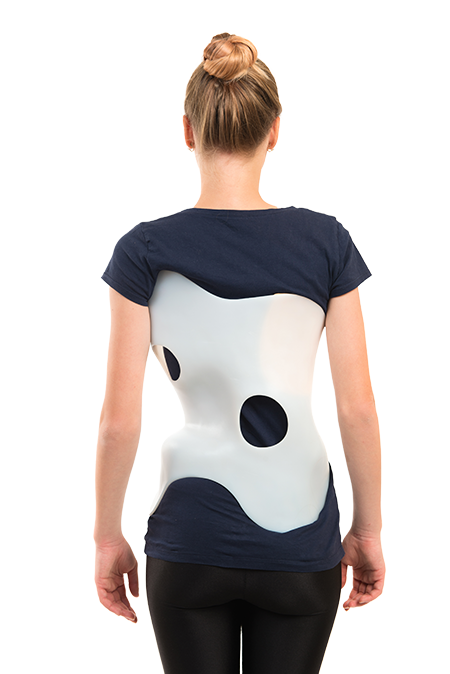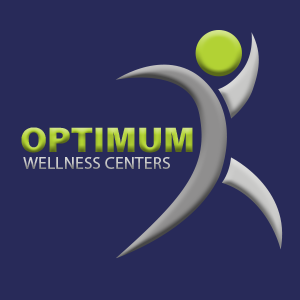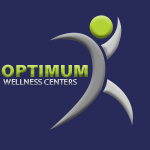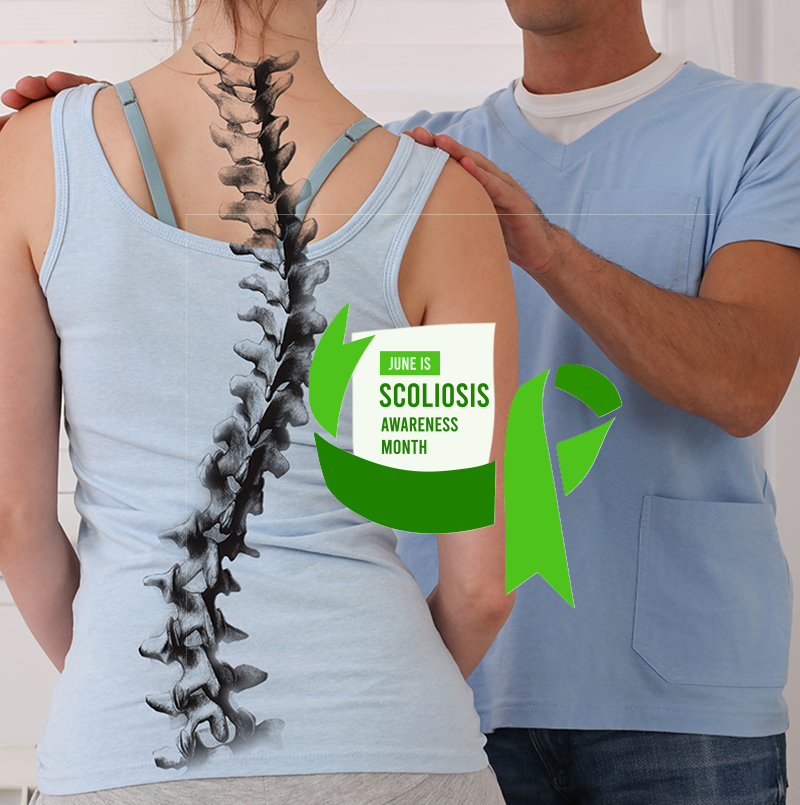June is Scoliosis Awareness month. And since a large part of our practice here at Optimum Wellness Centers is spine health, we have decided to highlight scoliosis and some of the current research that is being conducted in physical therapy to help people with this condition.
Many of us have heard of, or may even know of, someone who has scoliosis. But what is scoliosis? Scoliosis is a sideways or lateral curvature of the spine that typically occurs during a growth spurt or around puberty. In most cases, the cause is unknown, or idiopathic.
Two Categories of Scoliosis
Scoliosis is typically divided into two categories: structural and functional scoliosis. Structural scoliosis is the actual curvature of the spine. It can be congenital (present at birth), or develop due to hormone dysfunction among other issues. Some other causes of structural scoliosis include cerebral palsy and birth defects. Functional scoliosis is when a curve occurs due to a different underlying condition, such as a leg length discrepancy, or to make sure the head is upright and straight. In general, about 3% of adolescents have scoliosis. Although both boys and girls can develop scoliosis, girls have a higher likelihood of their scoliosis worsening. Scoliosis most often occurs in the thoracic and lumbar spine, but it can also occur in the cervical spine.
Scoliosis In Children and Teens
 For most children and teens, scoliosis is mild, but it can become more severe as the child/teen grows, most notably reducing the amount of space within the chest, making it difficult for the lungs to function properly. In most cases, treatment is unnecessary. However, children with scoliosis will need to be monitored closely with x-rays to see if the scoliosis progresses. If the scoliosis is severe enough, bracing or surgery may be necessary.
For most children and teens, scoliosis is mild, but it can become more severe as the child/teen grows, most notably reducing the amount of space within the chest, making it difficult for the lungs to function properly. In most cases, treatment is unnecessary. However, children with scoliosis will need to be monitored closely with x-rays to see if the scoliosis progresses. If the scoliosis is severe enough, bracing or surgery may be necessary.
What are some of the observable signs of scoliosis?
- An abnormal curve in the spine (typically lateral/ sideways)
- If more severe, a rotation in the spine will be observable
- The head may appear off center
- Shoulder/height may be asymmetrical
- One shoulder blade may be more prominent than the other
- Hip/ pelvis height may be asymmetrical
- Foot deformities
What are some of the other signs/symptoms of scoliosis?
- Back pain
- Muscle spasms
- Difficulty breathing
- Altered gait mechanics
How do physical therapists treat scoliosis?
It is important to note that other than corrective measures, scoliosis is not curable. However, with vigilance, stretching, and strengthening, scoliosis can be maintained, and greater flexibility gained. For those whose curve is more mild to severe, breathing exercises can be given to improve chest wall expansion and reduce the risk of hypoxia with activity. Additionally, with functional scoliosis, orthotics can be given to help reduce stress on other parts of the body that may be adversely affected.
In general, there is a growing body of research in physical therapy regarding specific exercises for scoliosis. The data and research regarding physical therapy treatment programs for scoliosis is mixed. That’s due to the varying exercises, inclusion criteria, ages, scoliosis Cobb angles, approaches, and referrals that make the data very difficult to interpret. Overall, there is limited data showing that combining specific exercises and bracing have been beneficial to individuals with scoliosis as compared to control groups.
What are physical therapy scoliosis-specific exercises (PSSEs)?1
- Exercises/ exercise program designed for scoliosis
- Goals:
- Prevent progression
- Reduce deformity
- Improve Quality of Life
- Aesthetics improvement
- Pain reduction
- Improvement of vital capacity and chest expansion
- Training for ADL activities
- Studied in:
- Adolescents with a Cobb angle of less than 25 degrees
- Adolescents with a risk of progression between 40-60%
- Adults with painful scoliosis
- These exercises are not an alternative to bracing and surgery, but are a supplement
- There is some evidence that PSSE helps, however, there is still a lack of quality studies in research
- In a randomized control trial by Monticone et al. 2014 of 110 subjects with Cobb angles between 10-25 degrees and >10 years of age2:
- Cobb angle:
- PSSE group: improvement of 69%, progression: 8%, stable/ no change: 23%
- Conclusion: PSSE can reduce the risk of progression in mild scoliosis and have significantly better results than general exercises
- Cobb angle:
- In a metal analysis by Answer et al 2015 of 9 studies3:
- PSSE can reduce COBB angle and improve quality of life in scoliotic patients
- PSSE are an effective treatment for scoliosis and are superior than general exercises
- Per the Society on Scoliosis Orthopedic and Rehabilitation Treatment (SOSORT) guidelines in 20114:
- PSSE are the first step to treat scoliosis and prevent progression
- Brace treatment must ALWAYS be accompanied by PSSE
- A combination of bracing and PSSE yielded the best results
- All of the treatment plans were designed by certified Physiotherapists
Schroth Exercises
- What are Schroth exercises?
- Auto-correction exercises as defined as the patient’s ability to reduce the spinal deformity through active postural realignment of the spine in three dimensions.
- Achieved through self-elongation and postural corrections that are specific for each curve pattern, and is eventually integrated in daily activities.
- In several cohort studies, the Schroth method demonstrated positive outcomes on back muscle strength, breathing function, slowing curve progression, improving Cobb angles and decreasing the prevalence of surgery.
- In a random control trial by Schreiber et al 2015 of 50 patients ages 10-18 with a cobb angle of 10-45 degrees5:
- Schroth group improved muscle endurance and the ability to keep an upright posture by 27.5% more than the control group.
- Had a significant improvement in pain and self-image
- Conclusion:
- Adding Schroth method exercises to standard plans of care offer significantly better results than standard care alone.
Position Statement for Adolescent Idiopathic Scoliosis 20156:
- Per the Scoliosis Research Society (SRS), Pediatric Orthopedic Society of North America (POSNA), American Academy of Orthopedic Surgeons (AAOS), and American Academy of Pediatrics (AAP):
- “AAOS, SRS, POSNA, and AAP believe that recent high quality studies demonstrate that the non-operative interventions such as bracing and scoliosis specific exercises can decrease the likelihood of curve progression to the point of requiring surgical treatment.”
References:
- PowerPoint by Nikos Karavidas, MSc, PT. Physiotherapeutic scoliosis specific exercises (PSSE): recent evidence for their effectiveness in scoliosis treatment and the position of the international scientific societies, an updated review. Accessed May 18, 2021. https://www.skoliosi.com/images/pdf/PHYSIOTHERAPEUTIC-SCOLIOSIS-SPECIFIC-EXERCISES-PSSE.pdf
- Monticone M, Ambrosini E, Cazzaniga D, Rocca B, Ferrante S. Active self-correction and task-oriented exercises reduce spinal deformity and improve quality of life in subjects with mild adolescent idiopathic scoliosis. Results of a randomised controlled trial. Eur Spine J. 2014 Jun;23(6):1204-14. doi: 10.1007/s00586-014-3241-y. Epub 2014 Feb 28. PMID: 24682356.
- Shahnawaz Anwer, Ahmad Alghadir, Md. Abu Shaphe, Dilshad Anwar, “Effects of Exercise on Spinal Deformities and Quality of Life in Patients with Adolescent Idiopathic Scoliosis”, BioMed Research International, vol. 2015, Article ID 123848, 15 pages, 2015. https://doi.org/10.1155/2015/123848
- Negrini et al.: 2011 SOSORT guidelines: Orthopaedic and Rehabilitation treatment of idiopathic scoliosis during growth. Scoliosis 2012 7:3.
- Schreiber, S., Parent, E.C., Moez, E.K. et al. The effect of Schroth exercises added to the standard of care on the quality of life and muscle endurance in adolescents with idiopathic scoliosis—an assessor and statistician blinded randomized controlled trial: “SOSORT 2015 Award Winner”. Scoliosis 10, 24 (2015). https://doi.org/10.1186/s13013-015-0048-5
- M. Timothy Hresko. SRS Statement on Physiotherapy Scoliosis Specific Exercises. Physiotherapy Scoliosis Specific Exercises: Scoliosis Research Society. Published May 19, 2014. Accessed May 19, 2021. https://www.srs.org/about-srs/quality-and-safety/position-statements/srs-statement-on-physiotherapy-scoliosis-specific-exercises
- Mayo Clinic. https://www.mayoclinic.org/diseases-conditions/scoliosis/diagnosis-treatment/drc-20350721. Accessed 5/13/2021.


